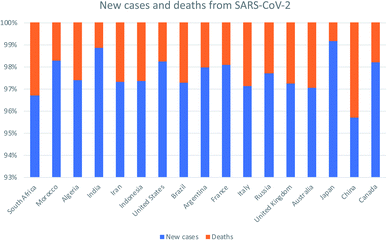
Mechanical behavior optimization of chitosan extracted from shrimp shells as a sustainable material for shopping bags
The use of biodegradable materials for shopping bag production, and other products made from plastics, has recently been an object of intense research-with the aim of reducing the environmental burdens given by conventional materials. Chitosan is a potential material because of its biocompatibility, degradability, and non-toxicity. It is a semi-natural biopolymeric material produced by the deacetylation of chitin, which is the second most abundant natural biopolymer (after cellulose). Chitin is found in the exoskeleton of insects, marine crustaceans, and the cell walls of certain fungi and

Nanomaterial-based drug delivery systems as promising carriers for patients with COVID-19
Once the World Health Organization (WHO) declared the COVID-19 outbreak to be pandemic, massive efforts have been launched by researchers around the globe to combat this emerging infectious disease. Here we review the most recent data on the novel SARS-CoV-2 pathogen. We analyzed its etiology, pathogenesis, diagnosis, prevention, and current medications. After that, we summarized the promising drug delivery application of nanomaterial-based systems. Their preparation routes, unique advantages over the traditional drug delivery routes and their toxicity though risk analysis were also covered
An eco-concerned development of a fast, precise and economical spectrophotometric assay for the antiviral drug simeprevir based on ion-pair formation
Simeprevir sodium (SMV) is one of the antiviral drugs used for the treatment of virus C. The current strategy develops and validates a new eco-concerned tool for its quantification in the pure and pharmaceutical formulations. Sulfonephthalein acid dyes were used for this purpose, applying visible analyses based on ion-pair formation. A linear relation between the absorbed signal and the drug concentration is obtained up to 67.0 μg mL-1 with r2 of 0.9989-0.9999. The measurement is carried out at 410, 415, 410, and 403 nm for bromocresol green, bromoxelenol blue, bromothymol blue, and
Study of Energy Harvesters for Wearable Devices
Energy harvesting was and still an important point of research. Batteries have been utilized for a long time, but they are now not compatible with the downsizing of technology. Also, their need to be recharged and changed periodically is not very desirable, therefore over the years energy harvesting from the environment and the human body have been investigated. Three energy harvesting methods which are the Piezoelectric energy harvesters, the Enzymatic Biofuel cells, and Triboelectric nanogenerators (TENGs) are being discussed in the paper. Although Biofuel cells have been investigated for a
Analytical Markov model for slotted ALOHA with opportunistic RF energy harvesting
In this paper, we investigate the performance of an ALOHA random access wireless network consisting of nodes with and without RF energy harvesting capability. We develop and analyze a Markov model for the system when nodes with RF energy harvesting capability are infinitely backlogged. Our results indicate that the network throughput is improved when the conventional nodes are underloaded. On the contrary, when all types of nodes have finite backlogs, we numerically demonstrate that the network throughput and delay are improved when the overall system is overloaded. We show that there exists a
Improvement of structural efficiency in metals by the control of topological arrangements in ultrafine and coarse grains
Improvement of structural efficiency in various materials is critically important for sustainable society development and the efficient use of natural resources. Recently, a lot of attention in science and engineering has been attracted to heterogeneous-structure materials because of high structural efficiency. However, strategies for the efficient design of heterogenous structures are still in their infancy therefore demanding extensive exploration. In this work, two-dimensional finite-element models for pure nickel with bimodal distributions of grain sizes having ‘harmonic’ and ‘random’

Nanocomposite matrix conjugated with carbon nanomaterials for photocatalytic wastewater treatment
The problem of hazardous wastewater remediation is a complicated issue and a global challenge. Herein, a layered Co0.5Ni0.5Fe2O4/SiO2/TiO2 composite matrix was prepared and incorporated with three carbon nanomaterials having different dimensionalities, carbon dots (C-dots, 0D), single-walled carbon nanotubes (1D), and reduced graphene oxide (2D), in an effort to create effective photocatalytic nanocomposites for chloramine-T removal from water. Microstructural analyses confirmed the formation of nanocomposites and revealed their chemistry and structure. Elemental mapping revealed a uniform

Nanostructured Mg substituted Mn-Zn ferrites: A magnetic recyclable catalyst for outstanding photocatalytic and antimicrobial potentials
With recently increasing the environmental problems and expected energy crisis, it is necessary to synthesis a low-cost, efficient, and UV-light responsive photocatalyst for contaminants’ degradation. The nanostructured spinel ferrite Mn0.5Zn0.5-xMgxFe2O4 NPs (x = 0.0, 0.125, 0.25, 0.375 and 0.50) were synthesized via the sol-gel method. The crystallite size was lied in nano regime ranging from 21.8 to 36.5 nm. The surface chemical composition of the Mn0.5Zn0.5-xMgxFe2O4 NPs was investigated via XPS analysis. Mossbauer spectra showed that the peaks were shifted to higher values of the maximum

Multistep deposition of Cu2Si(S,Se)3 and Cu2ZnSiSe4high band gap absorber materials for thin film solar cells
Cu2ZnSi(S,Se)4 and Cu2Si(S,Se)3 are potential materials to obtain cost effective high band gap absorbers for tandem thin film solar cell devices. A method to synthesize Cu2SiS3, Cu2SiSe3and Cu2ZnSiSe4thin film absorbers is proposed. This method is based on a multistep process, using sequential deposition and annealing processes. X-ray diffraction analysis performed on the final thin films have confirmed the presence of the Cu2Si(S,Se)3 and Cu2ZnSiSe4phases. Scanning electron microscopy images revealed the formation of polycrystalline layers with grains size up to 1 μm. The band gap of the
Study of fractional flux-controlled memristor emulator connections
In this paper, the series and parallel connections of the fractional flux-controlled memristors are studied. Asymmetric I-V hysteresis with high I-V nonlinearity can be obtained from single fractional memristor as reported in literature. However, connecting different memristor emulators can convert the asymmetric hysteresis to symmetric one and maintaining the high I-V nonlinearity to be used in some memristor devices. The proposed circuits have been analyzed mathematically to study the effect of changing the frequency and fractional power. Different cases have been verified on PSpice using
Pagination
- Previous page ‹‹
- Page 9
- Next page ››
